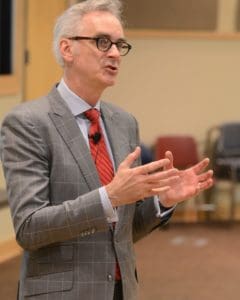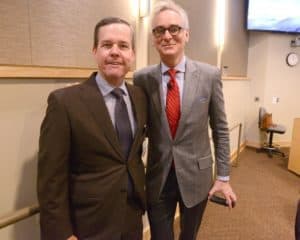Culinary Medicine Expert Visits UAMS, Sees Recipe for Success
| UAMS possesses all the ingredients for an interdisciplinary approach to culinary medicine, including a wellspring of enthusiasm on the subject, said the founder of a leading center in the area where medicine, cooking, education and healthy living overlap.
Timothy Harlan, M.D., executive director of the Goldring Center for Culinary Medicine at Tulane University, visited UAMS on Oct. 26. The creator of a culinary medicine curriculum now being adapted for offering at UAMS delivered a presentation on the Mediterranean diet — a foundation of his work, and also spent the day meeting with UAMS faculty and staff who are working to create a culinary medicine program here.

Timothy Harlan, M.D., executive director of the Goldring Center for Culinary Medicine at Tulane University, said he addresses his patients’ diets as part of their treatment plan. He helps his patients learn to eat foods based on the Mediterranean Diet.
Since the summer, a working group has been meeting at UAMS, led by Stephanie Gardner, Pharm.D., Ed.D., senior vice chancellor for academic affairs and provost, to explore how UAMS could expand on the Tulane curriculum in a program of its own. The effort sprang from a short conversation when Chancellor Cam Patterson, M.D., M.B.A., mentioned to Gardner how well received the curriculum when it was adopted at his previous location, Weill-Cornell Medical Center and Komansky Children’s Hospital/New York Presbyterian Hospital in New York.
“I thought with our strong interprofessional focus here, there would be a great opportunity to expand on the offerings at UAMS,” said Patterson, a longtime friend of Harlan’s, since they trained together as resident physicians. “This has turned into a statewide tidal wave and a lot of enthusiasm.”
Gardner said since the initial meeting in July, the working group grew to more than 60 participants, divided into five subcommittees — with participants from UAMS locations around the state and external partners such as culinary arts programs at UA-Pulaski Tech and Brightwater at the Northwest Arkansas Community College.
A medical education committee is working to integrate the Tulane curriculum for UAMS medical students, with module-based courses that could be offered as soon as this spring. An interprofessional education group is exploring opportunities to create culinary medicine activities as part of the interprofessional curriculum required for all UAMS students. Other groups include scholarship/research, continuing education and community engagement.
“There is unquestioned enthusiasm at UAMS for a program we believe will benefit our students, our patients and the state we serve,” Gardner said.
Before introducing Harlan, Gardner also highlighted culinary medicine activities surrounding the presentation that represented a kickoff for a program at UAMS:
- A group of medical students worked in the teaching kitchen of the Culinary Arts Institute at UA-Pulaski Tech to prepare a meal for the chancellor, while learning about culinary medicine concepts.
- A student cooking challenge hosted as an interprofessional education activity based on a case study involving federal SNAP benefits. Student teams prepared a meal of pan-seared tilapia, a squash medley and salad that would cost $2.63 per plate for a family of four.
- In Northwest Arkansas, students from the UAMS Northwest Campus participated in a kickoff event at the Brightwater culinary center.
In his presentation, Harlan highlighted rising rates nationally of diabetes, high blood pressure, obesity and stroke deaths as well as increased spending on health care. Dietary choices, he said, can cause and exacerbate all of those conditions.

Chancellor Cam Patterson, M.D., MBA, and Timothy Harlan, M.D., executive director of the Goldring Center for Culinary Medicine at Tulane University, trained together during their residency.
The Mediterranean Diet, inspired by the eating habits of those living in the European countries on the Mediterranean sea where the populations have lower rates of the above chronic conditions, has shown to lead to a better quality of life for patients and lower mortality rates, Harlan said. Even small diet modifications to incorporate foods based on the Mediterranean Diet can lead to noticeable improvements.
Harlan cautioned he is not approaching this as an adherent of alternative medicine techniques or calling for a strict naturalistic diet with no prescribing of medications to help control chronic conditions. “I am a Statin-writing, Western allopathic physician,” he said. “This [culinary medicine] is a piece we need in our tool box in a big way.”
Offering an overview of the diet, he pointed to a nine-point grouping of foods with suggested daily servings for men and women. “Just two points improvement will cause a 25 percent drop in all causes of mortality, irrespective of weight loss,” Harlan said. The diet can lead to weight loss but it’s not the overall goal, it’s more about the “way we eat and the quality of calories that we consume.”
Building on the concept of “tell me what you eat and I’ll tell you what you are,” Harlan said the ability to recall everything you’ve eaten in the past 48 hours is important and instructive when considering a patient’s condition and best treatment. “Dietary recall is more important than a family history,” he said.
For physicians, nurses, physician assistants and pharmacists, Harlan said, “walking the walk” is also critical. He pointed to smoking rates among physicians that were high in the 1950s and 1960s when more than half reported smoking. As health problems traced to tobacco and nicotine became more apparent, smoking rates among physicians declined dramatically in the successive decades. So when health professionals learn to make better dietary choices for themselves, it is often easier for them to have impactful conversations with their patients, he said.
“Culinary medicine is not a one-size-fits-all solution but part of a multi-modal approach,” he said, pointing to health coaching, nutrition counseling, exercise, medications, and other elements as part of an overall approach to improve a patient’s health and lifestyle.
